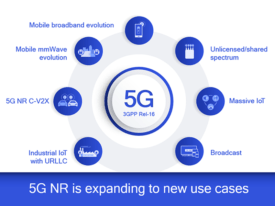This year is exceptionally exciting and action-packed for Qualcomm as their 5G vision is turning into a commercial relation for sub-6 GHz as well as mobile mmWave spectrum bands, with several 5G device and network rollout news are hitting the headlines slowly but steadily.
Qualcomm has been busy in publically demonstrating their 5G vision featuring a unified connectivity fabric for the last five years or so.
The company is now on its toes to expand the realms of the 5G technology to enable its partners, as well as customers, become more complete, competitive, successful, and innovative. To do so more effectively, the company is mulling over making substantial investments in gilt-edged system research and development.
You can sense the determination of Qualcomm by their recent statement on the upcoming, revolutionary over-the-air end-to-end 5G test networks to speed up 5G innovation.
These hybrid test networks include both mmWave and sub-6 GHz deployments and are destined to facilitate better validation of Qualcomm’s advanced 5G NR designs, revamping algorithms to better optimize the performance of 5G, along with indicating future 5G capabilities such as extended reality (XR) and ultra-low latency.

What the MWC19 Barcelona had in store for 5G:
This year’s Mobile World Congress in Barcelona saw Qualcomm bringing their advanced technology demonstrations to tempt the world with the future scope, capabilities, and functionalities of 5G.
 Let’s walk through a brief discussion of various 5G technology demonstrations showcased by the company at MWC 2019 in Barcelona:
Let’s walk through a brief discussion of various 5G technology demonstrations showcased by the company at MWC 2019 in Barcelona:
1. Sub-6 GHz SA Massive MIMO OTA Network
Qualcomm created a 3.5 GHz end-to-end 5G test network in San Diego, USA, compliant with the specifications of 5G NR Release 15, which included the Option 2 Standalone (SA) mode, for validating 5G NR operating in the Standalone configuration before it gets commercialized in the latter half of this year.
This demonstration by Qualcomm showcased the benefits of implementing an advanced multiuser massive MIMO gNodeB working with the 5G NR and 5G NextGen Core mobile test devices. Qualcomm is also deploying this for prototyping and validating several advanced features for Release 16.
2. Outdoor mmWave OTA Network
Qualcomm has also created an end-to-end 28 GHZ outdoor hotspot network to showcase the performance, robustness, and mobility of mmWave. It covers a number of real-life operational cases such as body/hand blocking as well as non-line-of-sight (NLOS) and line-of-sight (LOS) communications. Quite similar to the sub-6 GHz OTA network, the Release 15 network has been designed to facilitate forward compatibility. In addition, the company is also using it for prototyping and validating several Release 16 features.
3. Indoor 5G NR mmWave
The 5G NR mmWave is all set to create several new opportunities for indoor deployment such as enterprises and venues, offering low-latency connectivity and high-capacity multi-Gigabit per second download and upload speeds to desktops, laptops, smartphones, and more.
At its R&D center in New Jersey, Qualcomm has created an end-to-end OTA network to act as an indoor mmWave network testbed. The company has deployed a complex system simulation for showcasing the results in terms of achievable coverage, connectivity, and user experiences when co-running 5G NR mmWave RF with the current Wi-Fi and LTE infrastructure.
4. Sub-6 GHz Evolution
As the 3GPP Release 15 has established a foundation for advanced and superfast mobile broadband, several 5G NR technologies are coming up the ranks and ushering in the all-new levels of efficiency and performance.
This simulation demonstrates numerous features of the Release 16 that will accentuate massive MIMO performance and advanced power-saving efficiency of the devices, along with facilitating enhanced deployment of ultra-low latency services for the wireless edge.
5. 5G NR Cellular-to-Everything (C-V2X) Experience
Moving ahead with the momentum built by the 3GPP Release 14 C-V2X, the 3GPP Release 16 5G NR C-V2X has been designed to provide not just backward compatibility with Release 14, but for also ensuring the safety and performance of several new advanced use cases.
Qualcomm’s demonstration highlights that even during preliminary deployments of 5G NR C-V2X, the technology will come handy to provide reduced energy usage as well as faster travel for smart autonomous vehicles of tomorrow. In addition, it has the potential to provide enhanced situational awareness while guiding human drivers as we rush towards higher and constantly improving levels of autonomy.
6. Ultra-reliable 5G NR for Industrial IoT
The 3GPP Release 16 is likely to extend and optimize the deployment of 5G for high-performance industrial (IIoT) applications, thence providing new and advanced functionalities such as enhanced ultra-reliable low-latency communication (eURLLC). Moving ahead of 2018’s low-latency demonstration of 5G NR, this year’s Industrial IoT demonstration will showcase 99.9999% reliability achieved in Qualcomm’s over-the-air 5G test networks.
7. Shared Spectrum opportunities
Typically, 5G Coordinated Multi-point (CoMP) is emerging as a key enabler for numerous new 5G use cases.
For instance, CoMP can be effectively used for providing spatial diversity to address the need for enhanced ultra-reliable, low-latency (eURLLC) communication.
Also, the implementation of CoMP will offer high-efficiency spatial multiplexing to boost network capacity as well as deployment options for use cases like: two network operators using the same spectrum at once.
8. Boundless XR with 5G
Qualcomm has been determined to take the deployment of mobile extended reality (XR) – including augmented reality (AR) and virtual reality (VR) – to the next immersion level within the thermal and power constraints of a smartphone.
As part of this demonstration, the company showcased how the low latency and wider bandwidth of 5G can join forces with enhanced edge cloud and on-device processing to facilitate the development of boundless mobile XR experiences featuring photorealistic visuals.
Reference: Qualcomm and Fierce Wireless.

